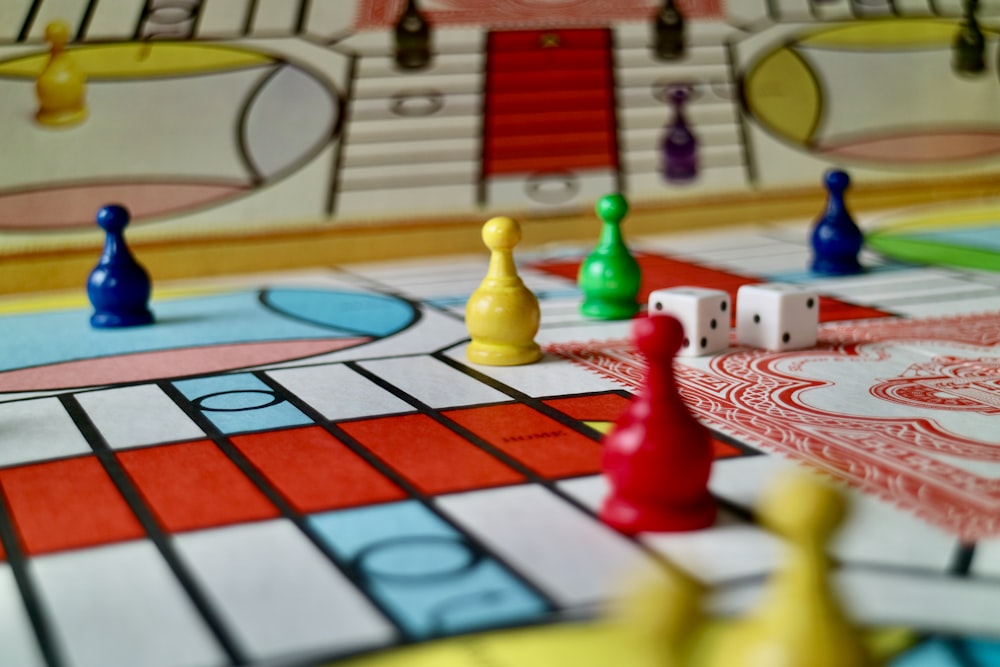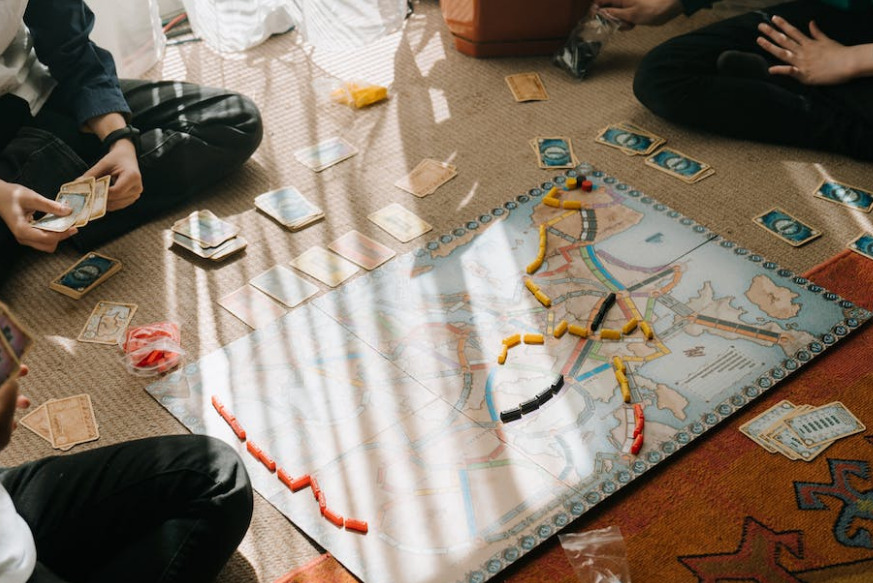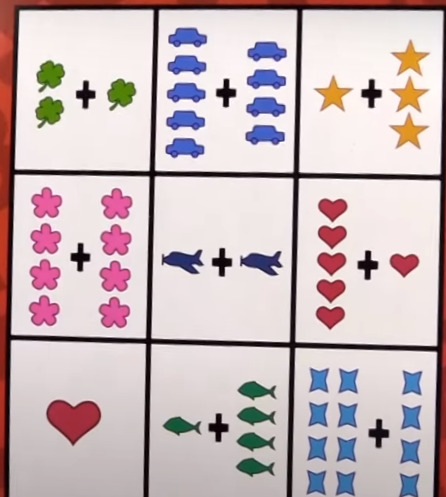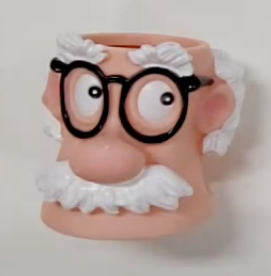Math board games are a type of board game that feature math operations and concepts as an integral part of their gameplay.
Not only can these games provide a break from the monotony of math lessons, they can also help students practice applying their math skills in a more relaxed and enjoyable way.
In the article below we’ll explore some of the ways parents can make effective use of math board games in a homeschool setting, their benefits and drawbacks, some things to keep in mind and, finally, provide some recommended games that parents can check out.
How Math Board Games Can Integrate With Math Lessons
Playing math board games at home can supplement and enhance math lessons in a number of ways.
Many math board games are actually centered around specific topics or concepts in math (multiplication, division, geometry and so on), which allows them to easily fit with a student’s lesson as a practice tool and which can make them excellent for low-stress, skill-focused remediation if made part of a regular routine.
A frustrated student struggling with their times tables, for example, might benefit from (and be more readily accepting of) focused practice in the form of a game, rather than doing more flashcard or workbook exercises.
In addition, math board games can provide the kind of multisensory learning experience that is often lacking from many math curricula.
As they move pieces around the board or otherwise manipulate game pieces students are able to blend hands-on and kinesthetic activity with mental math, math fact practice and other work.
This not only makes learning more entertaining and interesting (particularly for students with different learning preferences and those who struggle with traditional learning methods) but can also engage different cognitive pathways, leading to better math retention and understanding over time.
Finally, math board games can also be used as sort of a stealthy assessment tool.
By playing a board game centered around one or more topics a student has learned, parents can observe how well their child can apply their knowledge and skill in real time, which in turn can give them an idea of where they are strong and where they might need more support.
Benefits of Math Board Games For Homeschooling Families
As we’ve discussed in previous articles, for a variety of reasons math can often be an intimidating and frightening subject for students, and it’s not exactly uncommon for kids to develop a dislike of the subject or even become mathphobic.
For homeschooling families, this can make getting through lessons a bit harder and is often a reason for parents to seek out and find creative and engaging ways to go over concepts.
Math board games can be a great alternative to traditional practice, offering a number of benefits to students, regardless of skill level.
Math board games are a form of game-based learning, a method of teaching that integrates knowledge and skill-development into play, with learning and practice coming from playing the game, rather than assigned work.
More than that, math board games often include eye-catching boards, fun pieces and highly dynamic and sometimes very competitive gameplay – all of which are very useful in attracting students’ attention.

All of this can make learning a lot more engaging and fun for kids, and this greater engagement and active-learning style is known to promote greater long term retention of concepts.
Further, this fun and interactive learning approach can create a more low-pressure learning environment that can allow students to practice and improve their math abilities without the worry of getting things wrong.
Not only can this be an ideal solution for students who are terrified of the subject, but it can also be a great way to help just about any student build confidence and improve their attitude towards math.
Potential Disadvantages To Consider
While math board games certainly have their benefits as a dynamic and effective tool for reinforcing math skills and knowledge, they can have some potential drawbacks that parents need to be aware of.
Limited scope
Math board games tend to be limited in scope, usually focusing on just one major topic or concept at a time.
While this can make them ideal as a tool to help master certain aspects of math, parents wanting to work on a number of different topics may need to pick up a few different games, which can add up.
They aren’t necessarily very technologically advanced
While they certainly come in different styles and with different play mechanics, generally speaking math board games are pretty physical.
Students who prefer a more immersive high tech solution, with lots of detailed graphics, colors, music and animation, may not exactly find them very stimulating or exciting, which can limit their replay value and use as an unconventional practice tool to some degree.
Which leads us to our next section….
Math Board Games Vs Online Games and Apps
In our digital age, parents are surrounded by their choice of well-designed and cool looking online math games and apps that are intended to help their children hone their skills.
As a result, it sometimes feels as if old school board-and-dice math games are something of a relic.
While a typical math board game will never have the animated, high-tech look and feel of a good math video game, they still have a few unique advantages that online tools and games can’t really match.
For one thing, math board games tend to be far more multisensory.
In addition to seeing and listening, board games are a very kinesthetic and hands-on experience, with students rolling dice and/or physically moving objects and pieces around the board as they play.
In contrast, online math games and apps are (as one might expect from a screen-based product), more centered around the visual and auditory senses and, aside from moving a mouse or tapping a screen, lack a lot of a board game’s hands-on activity.
As a result of this, they may not be quite as appealing or effective with kinesthetic and tactile learners.
Another major advantage that math games have over their digital counterparts is that they can offer children a break from sitting in front of their computer or mobile device.
Today’s students spend a considerable amount of time sitting in front of a screen, both for their schoolwork and as entertainment, which some parents may be concerned about.
Based on physical items, math board games can offer families a more screen-free way of learning and practicing math skills.
Finally, math board games can also be a great way to promote family bonding and social interaction.
As most of these games are played against one or more opposing players, siblings, friends and other family members can come together to either compete against one another (hopefully in a friendly manner) or work together and communicate as a team to solve problems.
What To Look For In A Math Board Game
When considering a math board game there are a few things parents need to take into account.
Age range
One very important aspect of any board game is its intended age range.
Some games are aimed at younger children and consequently feature fairly easy questions centered around fairly essential math concepts, while others may be intended for an older audience and touch on more advanced concepts, such as geometry or even algebra.
Skill level
As they are based around academic ability and knowledge, parents also need to consider the skill level of any math board game.
While most games are aimed at a general audience and can be considered on-grade in terms of overall challenge and difficulty, some may be aimed at more advanced or talented math students and include far more challenging game play and questions that might frustrate unprepared students, rather than delight them.
Topical coverage
Another thing to keep in mind is that math board games can vary in terms of the math topics and concepts they cover.
Some games focus on broader related concepts, such as operations (adding, subtracting, multiplication and division) or counting and numeracy, while others might be more specific and touch on a single concept, such as multiplication or work with angles, making them good for more focused practice and remedial help.
Number of players
Board games can vary quite a bit when it comes to the number of players the game is designed for.
While some games are two player, many are designed to accommodate far larger groups.

This can be important information for larger families with multiple children, who may want to allow more family members to join in, homeschooling co-ops and students who just like to bring over their friends every so often.
Replay value
There’s probably nothing a parent hates more than buying a game and then seeing it collecting dust in the back of a closet after a few weeks.
A good board game should make students want to play it more than once and therefore should be enjoyable on subsequent plays, as well as challenging enough to keep students engaged but not too difficult so as to frustrate them and make them want to toss it in the trash.
Quality
Finally, on a more practical note, as with any other product parents should really consider a math board game’s overall quality.
Let’s face it, kids will be kids and any board game will need to stand up to their…spirited play.
Any game pieces should be big enough to be able to handle easily and be made of durable and well-finished ABS plastic, while any cardboard elements (boards, cards and so on) should be thick and tough enough not to tear when occasionally tugged on or twisted.
The game should also be relatively easy to set up and get started with (nobody likes spending an hour setting up and arranging a game that lasts 15 minutes) and it should come with clear, easy to understand step by step instructions that kids will ideally be able to understand on their own.
How Can Parents Know When A Child Is Ready For A Math Board Game?
It will perhaps come as no surprise to parents that determining if younger kids are ready to play a math board game can sometimes be a bit challenging.
Every child develops differently and a good deal depends on the individual child, their personality, their rate of development and so on.
That said, there are a few things that parents interested in picking up a math board game can look out for to determine if their child is ready to play and learn.
Math skills
Perhaps it goes without saying, but before playing a math board game that involves the use of specific math skills, a child should be fairly familiar with the underlying concept and have some ability to put it to use in order to prevent undue frustration and irritation.
Motor Skills
Most math board games require some level of fine motor skill to play properly and students do need to have a basic level of manual dexterity to play properly.
Although it depends on the individual game in question, games can involve moving small plastic pieces to specific slots, moving cards around, rolling dice, picking up small objects and more, things that can be a bit challenging to the very young.
Attention span
In order to play a math game properly, students do need the ability to sit and stay engaged for the duration of the game.
Parents should keep in mind that, on average, board games last about 30 minutes per play, which can be a long time for many younger kids to sit still and stay focused.
There are specific math board games out there with a more fast paced playstyle and/or simpler rules, which can a good idea for parents of young or more easily distracted students,
Understanding rules and following instructions
Board games tend to have very particular rules and instructions that detail their playstyle, and math games are no different.
Students do need to be able to understand the basic premise of a game, its essential rules for players and what they will be expected to do each turn in order to finish.
Ability to lose and handle frustration
Particularly when it comes to more competitive multiplayer games, kids need to be able to understand that they may lose and be able to handle that with some amount of grace.
While games can get heated and players might get frustrated at times, nobody wants to see a supposedly fun board game night end up in a mess of tears and scattered/broken game pieces.
Math Board Games We Recommend Checking Out
Prime Climb
Recommended age range: 10+
Suggested number of players: 2-4
Areas of math covered: Prime and composite numbers, operations, factoring
Prime Climb is a math board game that aims to help students in Grade 4 and up hone their skills in math topics such as prime and composite numbers, number theory, factor pairs, operations use and more.

A race-to-the-finish-style game, Prime Climb has students race their player piece across a colorful and wonderfully-designed spiral board to number 101, rolling two pairs of dice and, based on their result, strategically selecting which operation will get them closest to their destination…or knock their opponent back to the start.
Read our in-depth review of Prime Climb for more information
Or
Cloud Hoppers
Recommended age range: 6+
Suggested number of players: 2-4
Area of math covered: Addition, subtraction, sequencing, backwards counting
Cloud Hoppers is a frogger-style board game that has players try to get their cartoon alien creature down from their spaceship to the other side of the board (to a special flower) before their opponents by having it hop from cloud to cloud all the way down.

To do so, they roll a 10-sided dice, subtract the results from wherever they are at, move to the cloud that corresponds to the result and pick up a card with a skill-testing math problem.
Should they answer correctly, they can stay on their new cloud.
If not, it’s back they go.
Colorful, easy to learn and featuring funky looking aliens in a sci-fi theme, the game should captivate the attention of both young kids and their young at heart parents.
Check out Cloud Hoppers
Big Catch
Recommended age range: 8+
Suggested number of players: 2-4
Area of math covered: Division
Big Catch is a fishing-themed board game that aims to help students work on their division skills.
Te overall goal of the game is for players to help their fisherman be the first to get back to their “Home Island.”
At the start of each turn a player draws a card, which indicates how many fish they have caught.
Each island on the board is numbered (representing the island’s population) and players have to work out how to divide the number of fish they’ve caught by that number, with the resulting number being how many spaces they get to move and any remainders being kept as a reserve.
To add some spice to its gameplay, Big Catch also contains various rewards and surprises and even contains a few islands with helicopter pads, which can propel lucky players forward should they land on them.
In addition to the pieces (which can be used for hands-on division practice) the game comes with a set of pre-formatted whiteboard-like cards that can be used to practice long division, which is pretty cool and can be very helpful for older players.
ADSUMUDI
Recommended age range: 9+
Suggested number of players: 2-8
Area of math covered: Addition, Subtraction, Multiplication, Division
ADSUMUDI (which stands for Addition, Subtraction, Multiplication and Division) is a game that can really help students practice and sharpen their mental math skills for math operations.
The game involves students taking small, hexagonal multicolored pinwheel cards and having them try to get the number in the middle of each card by using some of the numbers surrounding it with any basic operation the player can think of (adding, subtracting, multiplying or dividing).
There are multiple difficulties to the game (from easy to monstrously hard), which differ in the amount of numbers that players will have to make use of.
At the hardest level, for example, users have to think up an equation that makes use of all 5 numbers on a card.
The first person to successfully figure out a solution yells “ADSUMUDI” and then presents their solution.
Should their math be correct, they collect a card and the first player to collect five cards wins.
Although the gameplay mechanics are fairly easy to understand, the challenge here really comes from players coming up with correct (sometimes fairly long) equations to a given answer in their head as quickly as possible, testing their mental math operations fluency as they do so.
Proof!
Recommended age range: 9+
Suggested number of players: 2-6
Area of math covered: Operations, Logic, Spatial Reasoning
Proof is a math card game that challenges players to come up with and solve equations quickly and accurately, honing their fluency skills.
The game itself is pretty quick to play and not all that hard to set up – players arrange 9 cards in a grid and race to see who can come up with an equation first.
After stating they have come up with an equation, players are challenged to “prove” it works to other players by demonstrating it in real time with the cards.
If it works out, the player keeps those cards and the player with the most cards at the end of the game wins.
Players are free to use a suite of math operations, from addition and subtraction to exponents, square roots and more, so the game easily can ramp up in challenge to meet student ability and grade level knowledge, making it good for older and younger students alike.
Sums in Space
Recommended age range: 5+
Suggested number of players: 2-4
Area of math covered: Addition, Subtraction
A space themed math board game, Sums in Space is a game aimed at early math learners that helps students practice their addition and subtraction skills.
Students aim to escape from a planet headed towards a black hole by zipping from planet to planet, rolling multi-sided dice to build and solving addition and subtraction problems as they go – first to the finish, wins.
There are three levels of difficulty in the game, allowing it to be configured to suit different ages and abilities.
Interestingly enough the game supports both competitive and cooperative gameplay, which can make it an intriguing board for families who want to encourage greater communication and teamwork.
ZINGO! 1-2-3
Recommended age range: 4+
Suggested number of players: 2-6
Area of math covered: Number recognition, Addition
ZINGO! 1-2-3 is a bingo-like game that can help young children learn and practice math skills such as number recognition, counting and basic addition and subtraction.
Each box includes a plastic device, called a Zinger, which when pulled pops out two of 72 number tiles.
Each player has a multicolored card with pictorial representations of numbers (green side) or basic operations (red), which allow the game to practice both number recognition and addition.

If a player has a tile that matches the tile (either directly or as an answer to an equation), they call out and take the tile.
The first to fill up their card and call out “Zingo” wins.
Interestingly, the game can be adapted to more complex formats, with players needing to get three in a row, be the first to set up a pattern and so on, making the game a bit more usable for older students, as well.
Monster Sock Factory:
Recommended age range: 6+
Suggested number of players: 2-4
Area of math covered: Multiplication, Division
In Monster Sock Factory, players need to help little cartoon monsters gather and hand out pairs of warm socks to their cold, often multi-legged, friends before time runs out.
Students start their turn by picking up an order card, which tells them how many socks they have to ship and the monsters they have to ship to, and then a packet of socks that matches the number of legs on their monsters.
Players collect sock packets until they can form an equation that matches the pairs of socks to the monster’s order and their legs (8 pairs of socks for 2 legs is 16 socks in total shipped).
The game has both easy and hard modes, which can help prevent younger kids from getting too frustrated (or more talented math students from getting bored), and the game can be played both competitively or cooperatively, which makes it a pretty creative and versatile game overall.
Check out Monster Sock Factory
Multiply Divide & Conquer
Recommended age range: 8+
Suggested number of players: 1-4
Area of math covered: Multiplication, Division
Multiply, Divide and Conquer stands out as a math board game due to its cooperative nature.
In this fantasy-inspired game, students practice basic multiplication and division by working together to defeat the red wizards (or red pawns) and their goo.
Students move across the board by rolling dice, solving math equations to collect helpful items, assault their enemies locations, attack goo chips and much, much more.
Rather than play against each other, students work to play against “the board” (kind of like playing against the computer in a video game).
After each student’s turn, players follow instructions to move the enemy pieces and their goo chips around, spreading chaos and adding a push-back element that students will have to work together to overcome.
The dynamic elements of Multiply, Divide and Conquer ke the game one of the more engaging math board games we’ve seen and far more like a classic strategy or role playing game than a simple educational tool.
Check out Multiply, Divide and Conquer
Math Builder
Recommended age range: 6+
Suggested number of players: 2-4
Area of math covered: Addition, Subtraction, Multiplication, Division
Math Builder is an interesting board game that is kind of like scrabble for math work.
Students have a grid-like board that they attach blue tiles to, creating equations (or “roads”) using different operators.
The longer the equation, the more points.
With each turn, students try to add on (or “build on”) to existing “roads” using tiles that they were given at the start, opening up the possibility for building some pretty impressive math equations.
The player with the most points at the end of the game, wins.
Ryte2Wyn
Recommended age range: 8+
Suggested number of players: 2-4
Area of math covered: Addition, Subtraction, Multiplication
Ryte2Wyn is a pretty easy to play and quick card game that can be a fun, student-centered and fast paced alternative to traditional flash card practice.
The game consists of a deck of colorful fantasy-inspired cards, with illustrations of heroes, knights, monsters and wizards drawn on their back.
Each card has a number on it and players battle it out by adding, subtracting or multiplying these numbers out, with the highest result winning the fight.
The winning player discards their highest card to their right and the player with the most cards in this pile wins.
Learning Resources’ Head Full Of Numbers
Recommended age range: 7+
Suggested number of players: 2-4
Area of math covered: Operations
If your family likes Boggle and wants something that can help them work on their general math operations skills, then they’ll probably get a kick out of Head Full Of Numbers.
The game’s main components are a set of six evens-and-odds dice (three normal, three with odds only), a big professor’s head-shaped plastic cup (from which the game derives its name) and a special pad of paper for writing things down.

Players set a timer, throw the dice and, from the results, race to see how many equations they can make and jot down before time runs out using any math operator they can think of (multidigit, addition, multiplication, exponents, decimals, fractions and so on).
Whoever has the most unique, valid equations wins the round.
Because of its open nature, the game can serve both younger students just starting out with addition and subtraction as well as much older students working with more complex equations…so long as their imagination can support it.
Check out Head Full of Numbers
Money Bags: A Crazy Coin Counting Game
Recommended age range: 7+
Suggested number of players: 2-4
Area of math covered: Identification of denominations, counting, adding and subtracting with money
While not every homeschooling family necessarily loves the topic, teaching kids about money and making transactions is an important and very practical part of their math education.
Money Bags is a math board game that comes with a number of plastic coins and fake paper money in various denominations.
Players start off with some coins and aim to be the first to make it to the end of the game board and the winner is the person with the most money at the end of play.
With each roll of the dice, players progress across the board and land on squares with various amounts of money printed on them that they will have to make in order to continue, keeping whatever change they make for themselves.
They also take a spin on a wheel, which adds some restrictions on what types of coins they can use to make an amount, and there are, of course, special squares that allow players to exchange small coins for larger ones or even for paper money.
In this way, the game can give students plenty of practice at identifying denominations and making change, which in turn gives them a good deal of practice in operations as they pertain to money.
Bottom Line
Math board games can be a dynamic and engaging way of reinforcing math knowledge and skill while keeping things low-stress and engaging.
From multiplication to money management, there are games out there to cover just about any math concept, skill level or age.
Math board games can not only offer a fun alternative to traditional workbook exercises and drill, which can help instill a greater appreciation for (or even love of) math, but they can also help students hone other important non-math skills, such as critical thinking, problem solving, patience and teamwork, which can help them immensely in their academic careers and in their day-to- day life.

About the Author
David Belenky is a freelance writer, former science and math tutor and a tech enthusiast. When he’s not writing about educational tech, he likes to chill out with his family and dog at home.
